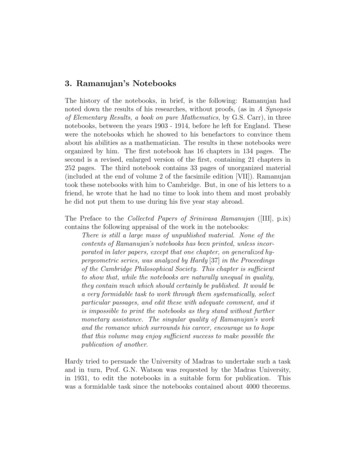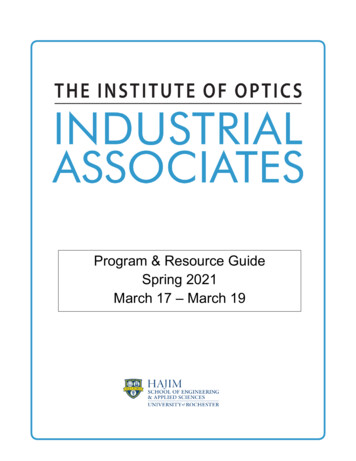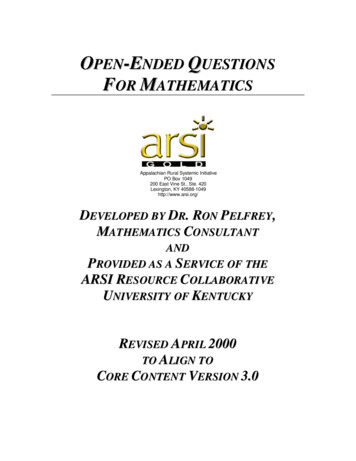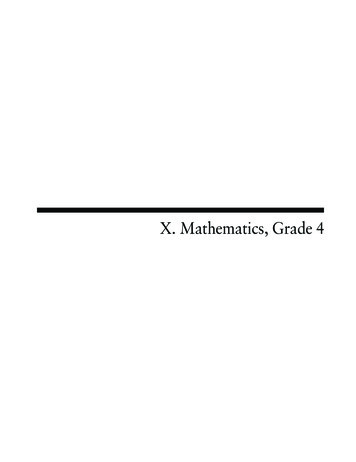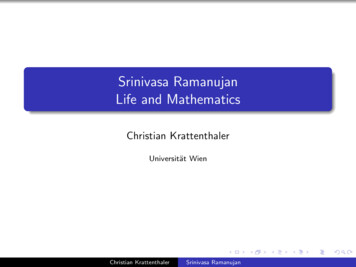
Transcription
Srinivasa RamanujanLife and MathematicsChristian KrattenthalerUniversität WienChristian KrattenthalerSrinivasa Ramanujan
Srinivasa Ramanujan(1887 – 1920)Christian KrattenthalerSrinivasa Ramanujan
Srinivasa Ramanujan(1887 – 1920)Christian KrattenthalerSrinivasa Ramanujan
Srinivasa Ramanujan(1887 – 1920)Christian KrattenthalerSrinivasa Ramanujan
Srinivasa Ramanujan(1887 – 1920)Christian KrattenthalerSrinivasa Ramanujan
Srinivasa Ramanujan(1887 – 1920)Christian KrattenthalerSrinivasa Ramanujan
Srinivasa Ramanujan(1887 – 1920)Christian KrattenthalerSrinivasa Ramanujan
Srinivasa Ramanujan(1887 – 1920)born 22 December 1887 in Erode (Madras Presidency Tamil Nadu)named Srinivasa Ramanujan IyengarChristian KrattenthalerSrinivasa Ramanujan
Srinivasa Ramanujan(1887 – 1920)born 22 December 1887 in Erode (Madras Presidency Tamil Nadu)named Srinivasa Ramanujan Iyengargrew up in Kumbakonam (Madras Presidency Tamil Nadu)Christian KrattenthalerSrinivasa Ramanujan
Christian KrattenthalerSrinivasa Ramanujan
Christian KrattenthalerSrinivasa Ramanujan
Srinivasa Ramanujan(1887 – 1920)Christian KrattenthalerSrinivasa Ramanujan
Srinivasa Ramanujan(1887 – 1920)1893 – 1897: Kangeyan Primary School in Kumbakonam1898 – 1904: Town High School of KumbakonamChristian KrattenthalerSrinivasa Ramanujan
Kumbakonam Town High SchoolChristian KrattenthalerSrinivasa Ramanujan
Srinivasa Ramanujan(1887 – 1920)1893 – 1897: Kangeyan Primary School in Kumbakonam1898 – 1904: Town High School of KumbakonamChristian KrattenthalerSrinivasa Ramanujan
Srinivasa Ramanujan(1887 – 1920)1893 – 1897: Kangeyan Primary School in Kumbakonam1898 – 1904: Town High School of Kumbakonamgot a copy of George Schoobridge Carrs “A Synopsis of Pureand Applied Mathematics”Christian KrattenthalerSrinivasa Ramanujan
Srinivasa Ramanujan(1887 – 1920)1893 – 1897: Kangeyan Primary School in Kumbakonam1898 – 1904: Town High School of Kumbakonamgot a copy of George Schoobridge Carrs “A Synopsis of Pureand Applied Mathematics”1904: joined Government Arts College in Kombakonam with ascholarshipChristian KrattenthalerSrinivasa Ramanujan
Srinivasa Ramanujan(1887 – 1920)1893 – 1897: Kangeyan Primary School in Kumbakonam1898 – 1904: Town High School of Kumbakonamgot a copy of George Schoobridge Carrs “A Synopsis of Pureand Applied Mathematics”1904: joined Government Arts College in Kombakonam with ascholarshiphe lost the scholarship the next year since — except formathematics — he performed very badlyChristian KrattenthalerSrinivasa Ramanujan
Srinivasa Ramanujan(1887 – 1920)Christian KrattenthalerSrinivasa Ramanujan
Srinivasa Ramanujan(1887 – 1920)1906 – 1912: constant search for a benefactor; survived bytutoring studentsChristian KrattenthalerSrinivasa Ramanujan
Srinivasa Ramanujan(1887 – 1920)1906 – 1912: constant search for a benefactor; survived bytutoring students1909: married to Janaki Ammal (1899 – 1994)Christian KrattenthalerSrinivasa Ramanujan
Srinivasa Ramanujan(1887 – 1920)1906 – 1912: constant search for a benefactor; survived bytutoring students1909: married to Janaki Ammal (1899 – 1994)1910: moved to Madras, with the support of R. RamachandraRao, a tax collectorChristian KrattenthalerSrinivasa Ramanujan
Srinivasa Ramanujan(1887 – 1920)Christian KrattenthalerSrinivasa Ramanujan
Srinivasa Ramanujan(1887 – 1920)1912: got a clerical post in the Accountant Generals Office ofthe Madras Port TrustChristian KrattenthalerSrinivasa Ramanujan
Srinivasa Ramanujan(1887 – 1920)1912: got a clerical post in the Accountant Generals Office ofthe Madras Port Trust1912: on encouragement of his benefactors, Ramanujan wroteto professors in England about his mathematical findingsChristian KrattenthalerSrinivasa Ramanujan
Srinivasa Ramanujan(1887 – 1920)1912: got a clerical post in the Accountant Generals Office ofthe Madras Port Trust1912: on encouragement of his benefactors, Ramanujan wroteto professors in England about his mathematical findings1913: one of them, Godfrey Harold Hardy, professor atCambridge University, was perplexed, and invited Ramanujanto come to England and to study at Cambridge UniversityChristian KrattenthalerSrinivasa Ramanujan
Godfrey Harold Hardy (1877 – 1947)“[These formulae] defeated me completely. I had never seenanything in the least like them before. A single look at themis enough to show that they could only be written down bya mathematician of the highest class. They must be truebecause, if they were not true, no one would have had theimagination to invent them.”Christian KrattenthalerSrinivasa Ramanujan
What is Hardy talking about?Christian KrattenthalerSrinivasa Ramanujan
What is Hardy talking about? s1e 2π1 1 5 55 1 2π/5 e22e 4π1 e 6π.Christian KrattenthalerSrinivasa Ramanujan
Srinivasa Ramanujan(1887 – 1920)Christian KrattenthalerSrinivasa Ramanujan
Srinivasa Ramanujan(1887 – 1920)17 March 1914: with a fellowship from Madras University,Ramanujan sails to EnglandChristian KrattenthalerSrinivasa Ramanujan
Srinivasa Ramanujan(1887 – 1920)17 March 1914: with a fellowship from Madras University,Ramanujan sails to England14 April 1914: Ramanujan arrives in LondonChristian KrattenthalerSrinivasa Ramanujan
Srinivasa Ramanujan(1887 – 1920)17 March 1914: with a fellowship from Madras University,Ramanujan sails to England14 April 1914: Ramanujan arrives in London1914 – 1919: Ramanujan studies and works with GodfreyHardyChristian KrattenthalerSrinivasa Ramanujan
Srinivasa Ramanujan(1887 – 1920)17 March 1914: with a fellowship from Madras University,Ramanujan sails to England14 April 1914: Ramanujan arrives in London1914 – 1919: Ramanujan studies and works with GodfreyHardy1916: Ramanujan is awarded the Bachelor degree ( Ph.D.)for a dissertation on “highly composite numbers”Christian KrattenthalerSrinivasa Ramanujan
Srinivasa Ramanujan(1887 – 1920)17 March 1914: with a fellowship from Madras University,Ramanujan sails to England14 April 1914: Ramanujan arrives in London1914 – 1919: Ramanujan studies and works with GodfreyHardy1916: Ramanujan is awarded the Bachelor degree ( Ph.D.)for a dissertation on “highly composite numbers”1918: Ramanujan is elected Fellow of the Royal Society(F.R.S.), on the proposition of Hardy and Percy AlexanderMacMahonChristian KrattenthalerSrinivasa Ramanujan
Srinivasa Ramanujan(1887 – 1920)Christian KrattenthalerSrinivasa Ramanujan
Srinivasa Ramanujan(1887 – 1920)1919: due to illness, on advice of Hardy he returns to India26 April 1920: Ramanujan dies in his home in KumbakonamChristian KrattenthalerSrinivasa Ramanujan
Entrance to Ramanujan’s home in KumbakonamChristian KrattenthalerSrinivasa Ramanujan
Ramanujan’s mathematical heritageChristian KrattenthalerSrinivasa Ramanujan
Ramanujan’s mathematical heritageRamanujan’s interests include infinite series, integrals, asymptoticexpansions and approximations, gamma function, hypergeometricand q-hypergeometric functions, continued fractions, thetafunctions, class invariants, Diophantine equations, congruences,magic squares.3 Notebooks37 published mathematical papers(J. Indian Math. Soc., Proc. London Math. Soc., Proc.Cambridge Philos. Soc., Proc. Cambridge Philos. Soc., Proc.Royal Soc., Messenger Math., Quart. J. Math.)the “Lost Notebook”Christian KrattenthalerSrinivasa Ramanujan
Ramanujan’s mathematical heritageThe 3 NotebooksRamanujan started to work on them during college time (maybeeven earlier). He continued working on them until his departure toEngland.The first notebook has 351 pages, organized in 16 chapters.The second notebook is a revised enlargement of the first. It has256 pages, organized in 21 chapters.The third notebook has only 33 pages.Christian KrattenthalerSrinivasa Ramanujan
excerpt from Notebook IChristian KrattenthalerSrinivasa Ramanujan
Ramanujan’s mathematical heritageThe 3 NotebooksAfter the death of Ramanujan, Hardy received copies of thenotebooks. He wanted the notebooks to be published and“edited”.In the late 1920s, George Neville Watson (1886 – 1965) and B. M.Wilson (1897 – 1935) began the task of editing the notebooks.They focussed on the second notebook. Wilson was assignedChapters 2–14, Watson was assigned Chapters 15–21. Wilson diedin 1935. Watson wrote over 30 papers inspired by the notebooksbefore his interest waned in the late 1930s.1957: The notebooks were published — without editing — by theTata Institute of Fundamental Research in Bombay.Christian KrattenthalerSrinivasa Ramanujan
Ramanujan’s mathematical heritageThe 3 NotebooksBruce Carl Berndt (*1939)1974: Bruce Berndt (not knowing at the time . . . ) started theproject of systematically proving all entries in the notebooks.1997: The project is completed by the publication of the fifthvolume of “Ramanujan’s Notebooks”, Part I–V.Christian KrattenthalerSrinivasa Ramanujan
Ramanujan’s mathematical heritageThe “Lost Notebook”George Eyre Andrews (*1938)1976: George Andrews visits the Wren Library of Trinity College inCambridge in order to see whether there is something interesting inG. N. Watson’s hand-written notes stored there. He found a pile ofpapers with Ramanujan’s handwriting there.Christian KrattenthalerSrinivasa Ramanujan
Ramanujan’s mathematical heritageThe “Lost Notebook”George Eyre AndrewsBruce Carl Berndt1998: Bruce Berndt and George Andrews start the project ofsystematically proving all identities in the “Lost Notebook”.2014: The project is essentially completed. Four volumes (out offive) of “Ramanujan’s Lost Notebook” are already published.Christian KrattenthalerSrinivasa Ramanujan
The Rogers–Ramanujan IdentitiesChristian KrattenthalerSrinivasa Ramanujan
The Rogers–Ramanujan Identities s1e 2π1 1 5 55 1 2π/5 e22e 4π1 e 6π.Christian KrattenthalerSrinivasa Ramanujan
The Rogers–Ramanujan Identities s1 e 2π1 5 55 1 2π/5 e22e 4π1 1 e 6π.One can show that1 q21 1 q3 2qnn 0 (q;q)nP qn(n 1)n 0 (q;q)nP q,q4.where (α; q)n : (1 α)(1 αq) · · · (1 αq n 1 ), n 1, and(α; q)0 : 1.1 Christian KrattenthalerSrinivasa Ramanujan
The Rogers–Ramanujan IdentitiesOne can show that1 q21 1 q31 Christian Krattenthaler2qnn 0 (q;q)nP qn(n 1)n 0 (q;q)nP qq4.Srinivasa Ramanujan.
The Rogers–Ramanujan IdentitiesOne can show that1 q21 q31 1 2qnn 0 (q;q)nP qn(n 1)n 0 (q;q)nP q.q4.Numerator and denominator factor!2 Xqn1 (q; q)n(q; q 5 ) (q 4 ; q 5 ) n 0and Xq n(n 1)n 0(q; q)n 1(q 2 ; q 5 ) (q 3 ; q 5 ) .These are the celebrated Rogers–Ramanujan identities.Christian KrattenthalerSrinivasa Ramanujan
The Rogers–Ramanujan Identities2 X1qn 5(q; q)n(q; q ) (q 4 ; q 5 ) n 0and Xq n(n 1)n 0(q; q)n 1(q 2 ; q 5 ) (q 3 ; q 5 ) Christian KrattenthalerSrinivasa Ramanujan.
The Rogers–Ramanujan Identities2 X1qn 5(q; q)n(q; q ) (q 4 ; q 5 ) n 0Christian KrattenthalerSrinivasa Ramanujan
The Rogers–Ramanujan Identities2 X1qn 5(q; q)n(q; q ) (q 4 ; q 5 ) n 0Combinatorics: the right-hand side rewritten:14(1 q)(1 q )(1 q 6 )(1 q 9 ) · · · XXXX q k1q 4k4q 6k6q 9k9 · · ·k1 0 Xqk4 0k6 0k1 ·1 k4 ·4 k6 ·6 k9 ·9 ···k9 0.Hence: the coefficient of q N on the right-hand side counts allpartitions of N into parts (summands) which are congruent to 1modulo 5.Christian KrattenthalerSrinivasa Ramanujan
The Rogers–Ramanujan Identities2 X1qn 5(q; q)n(q; q ) (q 4 ; q 5 ) n 0Christian KrattenthalerSrinivasa Ramanujan
The Rogers–Ramanujan Identities2 X1qn 5(q; q)n(q; q ) (q 4 ; q 5 ) n 0The left-hand side:2q n q 1 · q 3 · q 5 · · · q 2n 1Christian KrattenthalerSrinivasa Ramanujan
The Rogers–Ramanujan Identities2 X1qn 5(q; q)n(q; q ) (q 4 ; q 5 ) n 0The left-hand side:2q n q 1 · q 3 · q 5 · · · q 2n 1and11 2(q; q)n(1 q)(1 q ) · · · (1 q n ) · · ·X q k1 ·1 k2 ·2 ··· kn ·n .Hence: the coefficient of q N in this series counts all partitions of Ninto parts which are at most n.Christian KrattenthalerSrinivasa Ramanujan
The Rogers–Ramanujan Identities2 X1qn 5(q; q)n(q; q ) (q 4 ; q 5 ) n 0The left-hand side:2q n q 1 · q 3 · q 5 · · · q 2n 1and11 2(q; q)n(1 q)(1 q ) · · · (1 q n ) · · ·X q k1 ·1 k2 ·2 ··· kn ·n .Hence: the coefficient of q N in this series counts all partitions of Ninto parts which are at most n.Alternatively: the coefficient of q N in this series counts allpartitions of N into at most n parts.Christian KrattenthalerSrinivasa Ramanujan
The Rogers–Ramanujan Identities2 X1qn 5(q; q)n(q; q ) (q 4 ; q 5 ) n 0The left-hand side:2q n q 1 · q 3 · q 5 · · · q 2n 1and11 2(q; q)n(1 q)(1 q ) · · · (1 q n ) · · ·X q k1 ·1 k2 ·2 ··· kn ·n .The coefficient of q N in this series counts all partitions of N intoat most n parts.Christian KrattenthalerSrinivasa Ramanujan
The Rogers–Ramanujan Identities2 X1qn 5(q; q)n(q; q ) (q 4 ; q 5 ) n 0The left-hand side:2q n q 1 · q 3 · q 5 · · · q 2n 1and11 2(q; q)n(1 q)(1 q ) · · · (1 q n ) · · ·X q k1 ·1 k2 ·2 ··· kn ·n .The coefficient of q N in this series counts all partitions of N intoat most n parts.Altogether: the coefficient of q N on the left-hand side counts allpartitions of N where parts differ by at least 2.Christian KrattenthalerSrinivasa Ramanujan
The Rogers–Ramanujan IdentitiesLet N 9.The coefficient of q N on the right-hand side counts all partitions ofN into parts which are congruent to 1 modulo 5:9 6 1 1 1 4 4 1 4 1 1 1 1 1 1 1 1 1 1 1 1 1 1.The coefficient of q N on the left-hand side counts all partitions ofN where parts differ by at least 2:9 8 1 7 2 6 3 5 3 1.Christian KrattenthalerSrinivasa Ramanujan
The Rogers–Ramanujan IdentitiesRamanujan knew that he had no (rigorous) proof for the twoidentities.In 1917 he discovered that the identities had been proved byLeonard James Rogers (1862 – 1933) in 1894 [Second memoir onthe expansion of certain infinite products, Proc. London Math.Soc. 25, 318–343].Together, they published another proof of the identities in 1919[Proof of certain identities in combinatory analysis, Proc.Cambridge Philos. Soc. 19, 214–216].Independently, Issai Schur (1875 – 1941) had also rediscovered theidentities in 1917, again by a different approach.Christian KrattenthalerSrinivasa Ramanujan
The Rogers–Ramanujan IdentitiesThe proof by Ramanujan and RogersLetG (x) X1(1 xq 2r ) (x; q)r.( 1)r q 2 r (5r 1) x 2r(1 x) (q; q)rr 0Write 1 xq 2r 1 q r q r (1 xq r ), splitting the sum in twoparts. Associate the second part of each term with the first part ofthe succeeding term, to obtain X1(xq; q)r.G (x) ( 1)r q 2 r (5r 1) x 2r (1 xq 4r 2 )(q; q)rr 0Christian KrattenthalerSrinivasa Ramanujan
The Rogers–Ramanujan IdentitiesThe proof by Ramanujan and RogersLetG (x) X1(1 xq 2r ) (x; q)r.( 1)r q 2 r (5r 1) x 2r(1 x) (q; q)rr 0Write 1 xq 2r 1 q r q r (1 xq r ), splitting the sum in twoparts. Associate the second part of each term with the first part ofthe succeeding term, to obtain X1(xq; q)r.G (x) ( 1)r q 2 r (5r 1) x 2r (1 xq 4r 2 )(q; q)rr 0Now considerH(x) G (x) G (xq).1 xqChristian KrattenthalerSrinivasa Ramanujan
The Rogers–Ramanujan IdentitiesNow considerH(x) G (x) G (xq).1 xqChristian KrattenthalerSrinivasa Ramanujan
The Rogers–Ramanujan IdentitiesNow considerH(x) G (x) G (xq).1 xqSubstitute the second form for G (x) in the first expression and thefirst form in the second expression, to get X11 q r xq 3r 1 (1 xq r 1 ) (xq; q)rH(x) xq ( 1)r q 2 r (5r 1) x 2r.1 xq(q; q)rr 1Associating, as before, the second part of each term with the firstpart of the succeeding term, one obtainsH(x) xq(1 xq 2 )G (xq 2 ).Christian KrattenthalerSrinivasa Ramanujan
The Rogers–Ramanujan IdentitiesNow considerH(x) G (x) G (xq).1 xqSubstitute the second form for G (x) in the first expression and thefirst form in the second expression, to get X11 q r xq 3r 1 (1 xq r 1 ) (xq; q)rH(x) xq ( 1)r q 2 r (5r 1) x 2r.1 xq(q; q)rr 1Associating, as before, the second part of each term with the firstpart of the succeeding term, one obtainsH(x) xq(1 xq 2 )G (xq 2 ).Now considerK (x) G (x).(1 xq)G (xq)Christian KrattenthalerSrinivasa Ramanujan
The Rogers–Ramanujan IdentitiesNow considerK (x) G (x).(1 xq)G (xq)Christian KrattenthalerSrinivasa Ramanujan
The Rogers–Ramanujan IdentitiesNow considerK (x) G (x).(1 xq)G (xq)H(x) G (x) G (xq)1 xqThen, fromandH(x) xq(1 xq 2 )G (xq 2 ),one infersK (x) 1 1 xq1 K (xq)xq1 xq 21 Christian Krattenthaler.xq 3.Srinivasa Ramanujan
The Rogers–Ramanujan IdentitiesIn particular, for x 1,P r 12 r (5r 1)1r ( 1) q P .1K (1)( 1)r q 2 r (5r 1)1q1 1 r q2q31 .By the Jacobi triple product identity, X( 1)n q n(n 1)/2 x n (q; q) (x; q) (q/x; q) ,n this becomes1 q1 1 (q; q 5 ) (q 4 ; q 5 ) .(q 2 ; q 5 ) (q 3 ; q 5 ) q2q3.Christian Krattenthaler.1 Srinivasa Ramanujan
The Rogers–Ramanujan IdentitiesIf we writeF (x) G (x),(xq; q) thenF (x) F (xq) xqF (xq 2 ).By induction, one gets2 Xx n qnF (x) .(q; q)nn 0In particular,2 XqnG (1) F (1) (q; q)n(q; q) n 0(q 2 ; q 5 ) (q3; q5)(q; q) Christian Krattenthaler 1(q; q 5 ) (q 4 ; q 5 ) Srinivasa Ramanujan.
The Rogers–Ramanujan IdentitiesSimilarly,F (q) Xq n(n 1)n 0 (q; q)n G (q)(q 2 ; q) (q; q 5 ) (q 4 ; q 5 ) 1 2 5.(q; q) (q ; q ) (q 3 ; q 5 ) Christian KrattenthalerSrinivasa Ramanujan
The Rogers–Ramanujan IdentitiesAre these identities just curiosities?Christian KrattenthalerSrinivasa Ramanujan
The Rogers–Ramanujan IdentitiesAre these identities just curiosities?Not at all! Both expressions are modular forms of weight 0 Both are denominators in characters of the affine Kac–Moody(1)algebra of type A1 The identities were needed in the solution of the so-calledhard hexagon model by Rodney James Baxter (*1940).Christian KrattenthalerSrinivasa Ramanujan
The Rogers–Ramanujan IdentitiesAre these identities just curiosities?Not at all! Both expressions are modular forms of weight 0 Both are denominators in characters of the affine Kac–Moody(1)algebra of type A1 The identities were needed in the solution of the so-calledhard hexagon model by Rodney James Baxter (*1940). The identities inspired numerous variations, generalizations,etc.Christian KrattenthalerSrinivasa Ramanujan
The Rogers–Ramanujan IdentitiesThe Andrews–Gordon identitiesFor all positive integers k and i,Pk 1Xr1 ,.,rk 1 02Pk 1q j 1 Rj j i Rj (q; q)r1 · · · (q; q)rk 1 Yn 1n6 0, i (mod 2k 1)1,1 qnwhere Rj rj rj 1 · · · rk 1 .The Rogers–Ramanujan identities result for k 2 and i 1, 2.Christian KrattenthalerSrinivasa Ramanujan
Srinivasa Ramanujan(1887 – 1920)Christian KrattenthalerSrinivasa Ramanujan
Srinivasa Ramanujan (1887 { 1920) born 22 December 1887 in Erode (Madras Presidency Tamil
